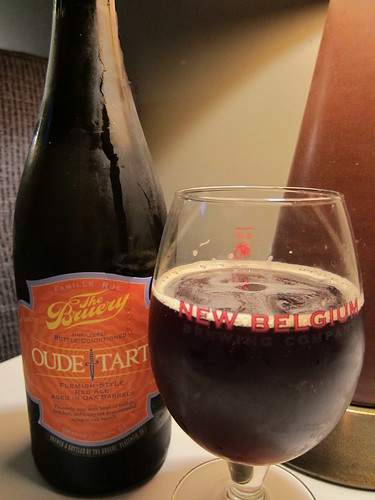
Flanders Red ales are a favorite style, so I’ve been looking forward to our review of the award winning Oude Tart from The Bruery. But first we need to take a slight detour into the price of craft beer.
Craft beer is, by its nature as a small batch product, expensive, when compared to Big Beer’s larger scale, costs are predictably high. But at what point is it too high? When does a bomber of beer become too expensive for consumers to pick up? After all, it’s only beer we are talking about. It could be amazing, delicious, mouth ravishing recipe, but its still just a beer.
As six pack prices have continued their increase, and as many brewers have shrunk six packs to four packs, blow-back from the community of fans that has supported these brewers is starting to be heard. Large format bottles or “bombers” are all the more expensive per ounce. So far, the growing craft beer market appears to be unaffected by complaints about price. But as special beers begin to cost more than decent domestic wine, consumers and beer geeks alike will begin to choose with their pocketbooks.
CRAFT BEER ISN’T WINE
Without getting too deep into the weeds of brewing economics, there are vast differences between wine and beer, and as such they should exist at different price points. The financial risks and man hours invested in maintaining and harvesting a vineyard are, to put it bluntly, way fucking higher. Let’s not make craft beer, in all its wonderful and unique glory, a poor imitation of the vintners art. Prices should be set at levels representing craft beer, which even at its finest, must be available to Joe six-pack.
When judging a beer, we rarely take cost into account. Unfortunately, at around $20 for a 750ml bottle, The Bruery Oude Tart pushes us to consider it. One factor that increases costs for brewers are beers that sit longer than normal. Aging beer is putting capital on the shelf, and that is not good for the bottom line. Aged 18 months, the Oude Tart takes a luxurious respite in red wine barrels. With this heavy investment in time and barrels, The Bruery can justify the high price if this turns out to be a world-class Flanders red. If not, the cost hurts what would otherwise be good, if not excellent beer.
TASTING NOTES

The Bruery Oude Tart is a big hardware winner:
- 2010 World Beer Cup Gold Medal Winner for the Belgian-Style Flanders Oud Brun or Oud Red category
- 2011 GABF Gold Medal Winner for the Belgian-Style Flanders Oud Brun or Oud Red category
- 2012 World Beer Cup Gold Medal Winner for the Belgian-style Flanders Oude Brun or Oud Red category
As a point of context, some of our favorites in this category from Belgium include Cuvee Des Jacobins Rouge by Brouwerij Bockor, Rodenbach Grand Cru and Clasic by Brouwerij Rodenbach N.V, and Duchesse De Bourgogne by Brouwerij Verhaeghe and domestic versions we like include The Lost Abbey’s Red Poppy. With The Bruery’s stellar reputation and awards, the expectations are high for this beer. So how does this The Bruery Oude Tart compare?
Pours a murky ruby color with almost no head or lacing. The nose is quite tart with red grapes and vinegar notes. On the palette this beer is highly acidic with big time sour flavor followed by hints of oak and red wine tannins. The mouth feel is surprisingly thin and crisp. Finish is more of the wine barrel, but not enough to balance the astringent, vinegar taste. At first the tartness draws you in like an Italian bitter apéritif, but the acidity soon overwhelms the experience.
Oude Tart is over all not a bad sour beer, but unfortunately not up to what the Belgians do, nor the Lost Abbey version. Were the price lower, I might buy it again, but for what it is, this is the rare exception from The Bruery that does not live up to the cost or expectations.
6.5/10
